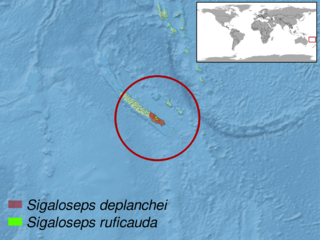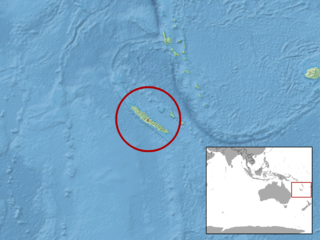Caledoniscincus is a genus of lizards in the family Scincidae (skinks). The genus is endemic to New Caledonia.

Graciliscincus is a lizard genus in the family Scincidae.
The New Caledonian leopard skink is a species of skink monotypic in the genus Lacertoides. It is endemic to New Caledonia.

Marmorosphax, is a genus of skinks native to New Caledonia.
Nannoscincus is a genus of small skinks, lizards in the family Scincidae. The genus is endemic to New Caledonia.

Sigaloseps is a genus of skinks which inhabit the moist, closed forest of southern New Caledonia.
The oange-bellied burrowing skink is a skink. It is monotypic in the genus Simiscincus. It is endemic to New Caledonia.

Tropidoscincus is a genus of skink. They are all endemic to New Caledonia.

Zootrophion is a genus of 23 known species of orchid, native to Central America, South America and the West Indies. The stems have inflated, flattened sheaths. The flowers bear sepals that fuse at their tips to form box-like structures that resemble animal's heads, hence the generic name, which means "menagerie".
- Zootrophion aguirreiP.Ortiz
- Zootrophion alvaroi(Garay) Luer
- Zootrophion argus(Kraenzl.) Luer
- Zootrophion atropurpureum(Lindl.) Luer
- Zootrophion beloglottis(Schltr.) Luer
- Zootrophion dayanum(Rchb.f.) Luer
- Zootrophion dodsonii(Luer) Luer
- Zootrophion endresianum(Kraenzl.) Luer
- Zootrophion erlangenseRoeth & Rysy
- Zootrophion gracilentum(Rchb.f.) Luer
- Zootrophion griffinLuer
- Zootrophion hirtziiLuer
- Zootrophion hypodiscus(Rchb.f.) Luer
- Zootrophion lappaceumLuer & R.Escobar
- Zootrophion leoniiD.E.Benn. & Christenson
- Zootrophion niveumLuer & Hirtz
- Zootrophion oblongifolium(Rolfe) Luer
- Zootrophion serpentinumLuer
- Zootrophion trivalve(Luer & R.Escobar) Luer
- Zootrophion vasqueziiLuer
- Zootrophion vulturiceps(Luer) Luer
- Zootrophion williamsiiLuer
- Zootrophion ximenae(Luer & Hirtz) ined.

The terror skink, also called Bocourt's terrific skink or Bocourt's eyelid skink, is a species of skink endemic to the Île des Pins, a small islet off the coast of New Caledonia. First described in 1876, it was presumed to be extinct, but was rediscovered in 1993, and since then several individuals have been seen. Because of its small area of occupation and small population size, the International Union for Conservation of Nature has assessed its conservation status as being "endangered".

Geoscincus is a monotypic genus of skinks: the only accepted species is Geoscincus haraldmeieri.
Dierogekko, sometimes known as the striped geckos, or the New Caledonian geckos, is a genus of lizards in the family Diplodactylidae endemic to New Caledonia. It includes nine species:
The blue-mouthed skink is a skink in the. It is monotypic in the genus Caesoris.. It is endemic to New Caledonia.
Celatiscincus is a genus of skinks. Both species are endemic to New Caledonia.
Kanakysaurus is a genus of skinks.
Phasmasaurus is a genus of skinks. Both species are endemic to New Caledonia.
Kuniesaurus albiauris is a species of skink endemic to New Caledonia. It is the only species in the monotypic genus Kuniesaurus. It is only known from a small patch of dense coastal forest with limestone substrate on the Isle of Pines. Due to its very small and restricted habitat, it is highly threatened by invasive species such as the little fire ant. It has been proposed that Kuniesaurus be classified as Critically Endangered on the IUCN Red List.
Greer's tree skink is a species of lizard in the family Scincidae. It is found in New Caledonia.
Epibator insularis is a species of lizard in the family Scincidae. It is found in New Caledonia.
The green-bellied tree skink is a species of lizard in the family Scincidae. It is found in New Caledonia.






